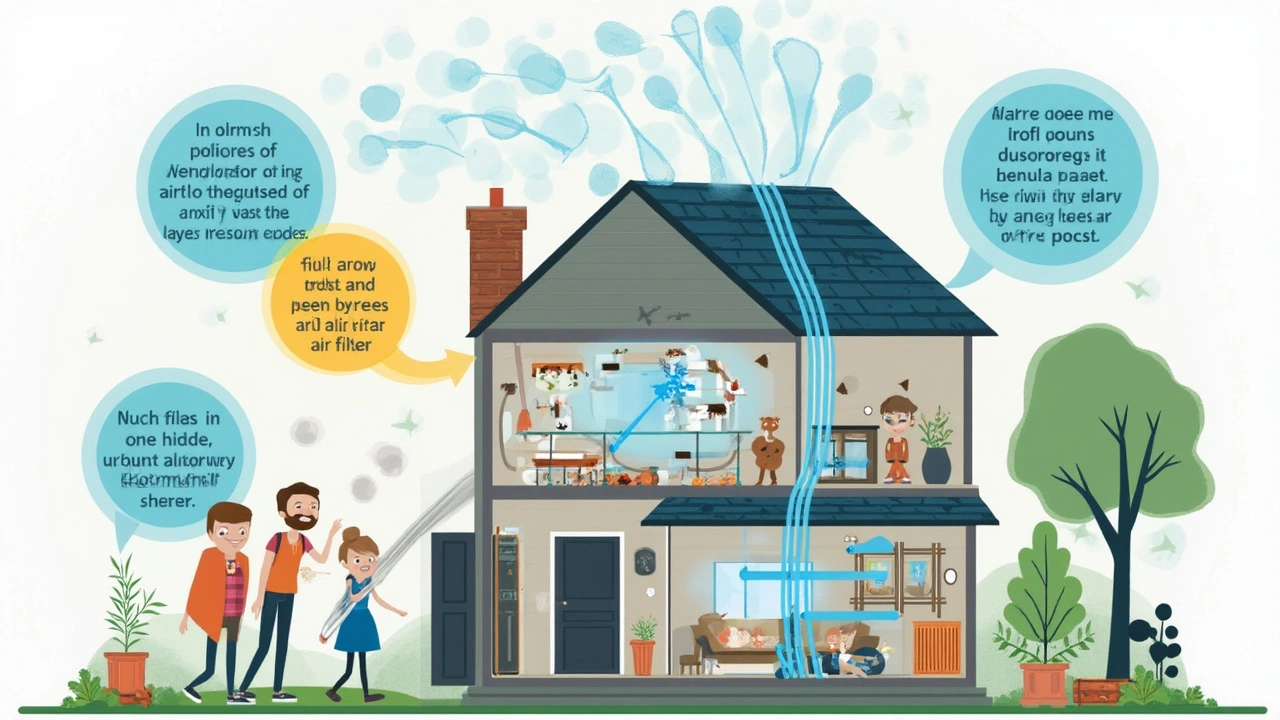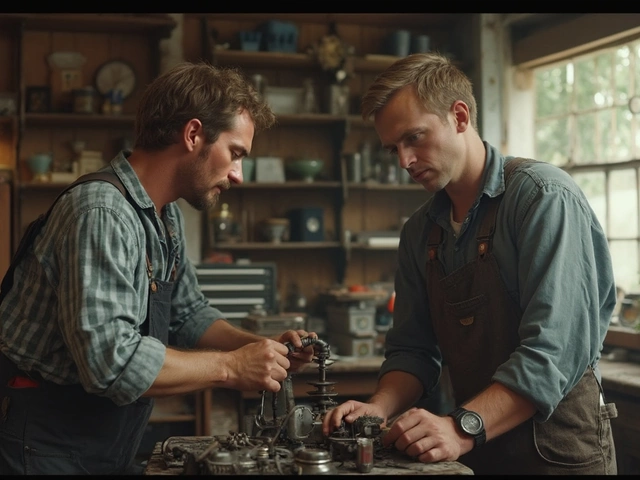You know that dusty smell when you first fire up the AC or heater? Nine times out of ten, that's your air filter waving a white flag. Most people forget about their filters—until the air gets stuffy, allergies start flaring up, or the energy bill creeps higher each month. The reality? A dirty air filter can throw your whole system off, from poor airflow to serious breakdowns.
So how do you tell if your filter desperately needs a clean? Don’t wait for choking dust clouds or weird smells. The real signs show up way sooner—think weak airflow coming out of your vents, more sneezing than usual, or maybe your system just doesn't cool or heat like it used to. There's even a smart trick: hold your filter up to the light. If you can’t see light through it, you’re well past due.
- Why Air Filters Matter More Than You Think
- Clear Signs Your Air Filter Needs Cleaning
- Different Types, Different Schedules
- How to Check Your Filter Like a Pro
- Cleaning vs. Replacing: What’s Smarter?
- Keeping Clean: Tips That Actually Work
Why Air Filters Matter More Than You Think
Most people look at air filters as just another thing on their to-do list. But the truth? That little filter does a lot more than you realize. It’s basically the gatekeeper for your home’s air. When it’s clean, it stops dust, dirt, pollen, and even pet dander from floating around and getting into your lungs or clogging up your AC or heater.
This isn’t just about comfort. According to the EPA, indoor air can be up to five times dirtier than outdoor air—pretty wild considering how much time we spend inside. Poor indoor air isn’t good for anyone, but it hits kids, older folks, and people with allergies or asthma the hardest. That’s where your air filter jumps in to help.
Let’s put some real numbers behind it. A clogged filter can cut down your HVAC’s efficiency by as much as 15%. That means your system works harder to push air through all that gunk, which hikes up energy bills and can even shorten the life of the whole thing. Here’s how it plays out in practice:
| Issue | Dirty Filter Impact |
|---|---|
| Air Quality | More dust and allergens, stuffier air |
| Energy Costs | Bills can increase up to 15% |
| System Lifespan | Extra strain can lead to breakdowns |
If you see more dust settling on your furniture or notice your allergies flaring up at home, a neglected air filter is often the silent culprit. Plus, when you forget about it for too long, dirt and debris can build up in your system, leading to expensive repairs or even a full system fail. It’s way cheaper and easier to stay on top of your filter than to call out a technician later.
Clear Signs Your Air Filter Needs Cleaning
Don’t wait for a disaster. Your air filter will throw out signals way before you notice obvious problems. You just need to know what to watch for—or better, what to smell, hear, or even feel.
- Air filter looks gray, dark, or caked in dust. If you pull it out and it’s the color of pavement, cleaning isn’t optional—it’s urgent.
- Allergies seem worse indoors. If you keep sneezing or your eyes itch indoors, a dirty air filter might be tossing dust and pollen back into the air.
- Weak airflow. If you walk by the vent and barely feel a breeze, there’s a good chance your filter is clogged, making your system work like it’s trying to suck a milkshake through a straw.
- Odd smells. Musty, dusty, or burnt smells coming out of your AC or heater are red flags. Trapped debris and bacteria can mix together to create these stinky odors.
- More dust on surfaces. See dust building up fast on furniture? Your filter probably isn’t catching as much as it should.
- HVAC runs longer. If your system stays on longer than usual just to hit the same temperature, it’s likely working overtime because of a blocked filter.
It’s easy to shrug off these warning signs, but waiting can cost you—literally. According to the U.S. Department of Energy, replacing a dirty filter can lower your air conditioner’s energy use by 5% to 15%. And research from home warranty companies shows between 70-80% of AC service failures are caused by neglecting filter maintenance. So, keeping tabs on your filter actually saves money and avoids the headache of unexpected repairs.
| Sign | What It Means |
|---|---|
| Dusty/Gray Filter | Dust, pet hair, or pollen trapped; airflow restricted |
| Weaker Airflow | Filter is clogged; system can't push air easily |
| More Allergies | Irritants aren't getting trapped, causing symptoms |
| System Runs Longer | Blocked filter makes your unit work harder |
| Bad Odors | Bacteria or mold buildup in/around the filter |
If you spot more than one of these at home, don’t wait. A few minutes with your filter can save you a giant headache down the road.
Different Types, Different Schedules
Not every air filter is made the same, and that means their cleaning schedules are all over the place. Some need attention every month, others can go on for half a year, and some are designed to be tossed out instead of cleaned. You don’t want to treat them all the same—that’s the fast track to wasting money or breathing in dusty air.
Let’s break things down by type:
- Fiberglass filters: These are the super-basic, usually blue or white filters you find in a lot of older homes. Cheap and thin, they trap bigger stuff like dust and lint, but not much more. Most of these need swapping every 30 days, not cleaning—they don’t stand up well to scrubbing and rinsing.
- Pleated filters: Made of paper or polyester, these fold like an accordion to trap more dust and pollen. Some can be gently vacuumed, but regular replacement every 2–3 months is the way to go for cleaner air.
- Washable (reusable) filters: These are built sturdier, often with a metal frame. You’ll need to clean them every 30–60 days, depending on how dusty your place gets. Letting them dry fully is key—otherwise, you can end up with mold instead of clean air.
- HEPA filters: Super serious about filtering pollen, smoke, and even tiny particles. Most HEPA filters (think air purifiers) aren’t made to be cleaned—just replaced, usually every 6–12 months. Washing them can ruin the material.
- Car cabin filters: Keep the inside of your ride fresh. Needs checking at least once a year, or every 12,000–15,000 miles, depending on city traffic or dirty roads.
Researchers at the EPA say homes with pets, lots of traffic, or smokers should replace filters more often—sometimes double the speed of a pet-free house. Plus, most modern HVAC systems list the recommended filter schedule right on the access panel.
| Filter Type | Typical Maintenance | Replace or Clean? |
|---|---|---|
| Fiberglass | Every 1 month | Replace |
| Pleated | Every 2-3 months | Replace |
| Washable (Reusable) | Every 1–2 months | Clean |
| HEPA | Every 6–12 months | Replace |
| Car Cabin Filter | Every 12K–15K miles | Replace/Clean |
Bottom line? Check what kind of filter you've got and stick to the proper schedule. Cleaning or replacing on time does more for your air filter than any fancy gadget will.

How to Check Your Filter Like a Pro
If you’ve never checked your air filter before, don’t worry—it’s not rocket science. You just need to know where to look and what to look for. A clogged air filter isn’t always obvious, but a few quick checks make a big difference, especially for air filter upkeep. Ignoring this step means more dust in your lungs and higher energy bills. Not worth it.
Here’s the go-to routine to see if your filter’s overdue for a clean or swap:
- Turn it off first. Always cut power to the unit (furnace, AC, or air purifier) before you mess with the filter. Safety first—nobody needs an unexpected zap or a sneeze attack.
- Find the filter. In a central AC or furnace, it’s usually behind a return vent or right at the system. Cars have them under the hood or behind the glove box. Air purifiers? It’s usually behind a latch or panel.
- Pop it out. Slide or lift the filter out gently. Look for a build-up of gray or black dust, fuzz, pet hair, or anything that doesn’t belong.
- Do the light test. Hold it up to a bright light or even your phone flashlight. Can you see through it clearly? If not, it needs cleaning or replacing. Simple.
- Sniff test. If you notice a musty or stale smell up close, that’s a classic sign you’ve got trapped dust, mold, or even bacteria brewing—big yikes for air quality.
Some folks get fancy with vacuum cleaners or special filter brushes, but honestly, a visual and sniff check are usually enough. If you find caked-on dust or the filter looks almost brown, don’t waste time: clean it or get a new one.
Think it’s all hype? Check this out—according to the EPA, a clean filter can improve your system’s efficiency by up to 15%. That’s real money saved and better air every day. Here’s a quick comparison for common filter check frequencies:
| Type of System | How Often to Check |
|---|---|
| Central HVAC | Once a month |
| Window/Portable AC | Every 2-4 weeks |
| Car Cabin Filter | Every 6 months or 12,000 miles |
| Air Purifier | Every 2-3 months |
Remember, dusty environments and homes with pets might need filter checks even more often. So, don’t trust the calendar—trust what you see and smell.
Cleaning vs. Replacing: What’s Smarter?
If you’ve figured out your air filter is dirty, you’ve got two main moves: clean it or toss it and get a new one. The answer depends on the air filter type and what you want for your air quality and budget.
Washable (also called reusable) air filters can handle a good cleaning. Pull them out, give them a rinse with water, and let them dry before you slide them back in. These filters usually last three to five years if you clean them every one to three months. It’s easy; no need to buy a new one every time unless it’s torn or permanently clogged.
Disposable filters are a different ballgame. Trying to clean one of these actually makes things worse. Dust and dirt get jammed deeper into the fibers. Don’t bother; just replace with a fresh filter—usually every 30 to 90 days, but check your system’s manual. No need to spend more: most homes work just fine with standard pleated filters instead of the fancy, expensive options.
Take a look at this quick breakdown to see when it’s worth cleaning or when it's time to replace:
| Filter Type | Clean or Replace? | Frequency | Average Cost |
|---|---|---|---|
| Washable/Reusable | Clean | Every 1–3 months | $20–$50 (lasts years) |
| Disposable (Fiberglass/Pleated) | Replace | Every 1–3 months | $5–$20 per filter |
The big payoff? Clean or new filters make your HVAC run smoother and use less power. The Department of Energy says swapping a clogged filter for a clean one can cut your energy use by up to 15%. Not bad for such a simple job, right?
If you have pets, live in a dusty area, or run your system all the time, you’ll need to clean or swap your filter more often. And if you start seeing rips, stubborn stains, or a filter that won’t get clean (for reusables), it’s time to retire it. Better to spend a few bucks now than risk blowing out your whole system later.
Keeping Clean: Tips That Actually Work
If you're tired of guessing when to check your air filter, here's the real deal: set a reminder every 30 days. Air filters might claim to last three months, but that depends on your space, pets, and air quality. If you've got dogs, cats, or anyone who smokes in the house, you’ll want to peek at your filter way more often. One survey found that homes with pets need new or cleaned filters around every 60 days, not 90.
To keep your air filter doing its job, make checking a regular thing. Here's a no-nonsense routine:
- Mark your calendar or set a phone reminder for a 30-day filter check, not just replacement.
- If the filter looks gray, caked with dust, or makes it tough to see light through it, clean or swap it out.
- Vacuum reusable or foam filters gently. If it’s a disposable one, don’t try to stretch its life—just replace it.
- Keep extra filters handy so you don’t end up putting it off. They’re cheap and make a big difference.
When was the last time you dusted your vents and returns? Clean vents mean your filter lasts longer and your air system doesn’t have to work as hard. Even wiping vent grilles with a damp cloth every few weeks helps keep extra dirt out of your filter.
Ever wonder how much money you’re wasting when you skip filter maintenance? Check out this quick table:
| Condition | Effect on Energy Use | Possible Cost per Year |
|---|---|---|
| Clean filter, changed regularly | Normal | $0 (baseline) |
| Dirty filter, changed once per year | Up to 15% higher | $120 (on $800/yr bill) |
If you want easy breathing and a lower bill, keeping a filter clean is simple: check, clean, repeat.






